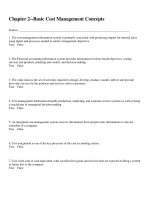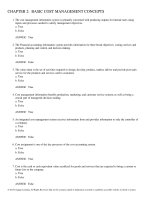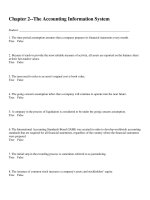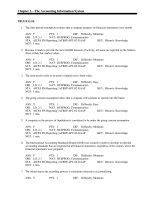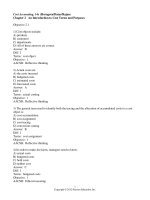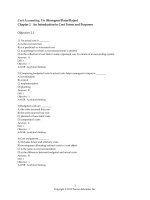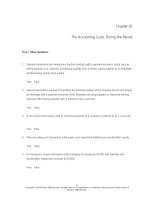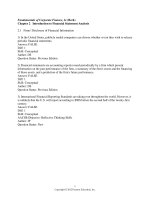Fundamentals of cost accounting 4th edition lanen test bank
Bạn đang xem bản rút gọn của tài liệu. Xem và tải ngay bản đầy đủ của tài liệu tại đây (10.76 MB, 233 trang )
Chapter 02
Cost Concepts and Behavior
True / False Questions
1.
The cost of an item is the sacrifice of resources made to acquire it.
True
2.
An expense is an expired cost matched with revenues in a specific accounting period.
True
3.
False
An asset is a cost matched with revenues in a future accounting period.
True
4.
False
False
Accounting systems typically record opportunity costs as assets and treat them as intangible items
on the financial statements.
True
5.
False
Total cost of goods purchased minus beginning merchandise inventory plus ending merchandise
inventory equals cost of goods sold.
True
6.
False
Cost of goods sold includes the actual costs of the goods sold and the cost of selling them to the
customer.
True
False
2-1
© 2014 by McGraw-Hill Education. This is proprietary material solely for authorized instructor use. Not authorized for sale or distribution in
any manner. This document may not be copied, scanned, duplicated, forwarded, distributed, or posted on a website, in whole or part.
7.
Period costs are those costs assigned to units of production in the period in which they are
incurred.
True
8.
Only direct costs can be classified as product costs; indirect costs are classified as period costs.
True
9.
False
False
The three categories of product costs are direct materials, direct labor, and manufacturing
overhead.
True
False
10. The first step in determining whether a cost is direct or indirect is to specify the cost allocation rule.
True
False
11. Total work-in-process during the period is the sum of the beginning work-in-process inventory and
the total manufacturing costs incurred during the period.
True
False
12. Cost of goods sold plus the ending finished goods inventory minus the beginning finished goods
inventory equals the cost of goods manufactured.
True
False
13. If the cost of goods manufactured during the period exceeds the cost of goods sold, the ending
balance of Finished Goods Inventory account increased.
True
False
14. Total variable costs change inversely with changes in the volume of activity.
True
False
2-2
© 2014 by McGraw-Hill Education. This is proprietary material solely for authorized instructor use. Not authorized for sale or distribution in
any manner. This document may not be copied, scanned, duplicated, forwarded, distributed, or posted on a website, in whole or part.
15. Fixed costs per unit change inversely with changes in the volume of activity.
True
False
16. The range within which fixed costs remain constant as volume of activity varies is known as the
relevant range.
True
False
17. The term full cost refers to the cost of manufacturing and selling a unit of product and includes
both fixed and variable costs.
True
False
18. Variable marketing and administrative costs are included in determining full absorption costs.
True
False
19. Revenue minus cost of goods sold equals contribution margin.
True
False
20. The primary goal of the cost accounting system is to provide managers with information to prepare
their annual financial statements.
True
False
Multiple Choice Questions
2-3
© 2014 by McGraw-Hill Education. This is proprietary material solely for authorized instructor use. Not authorized for sale or distribution in
any manner. This document may not be copied, scanned, duplicated, forwarded, distributed, or posted on a website, in whole or part.
21. Which of the following statements is (are) true?
(1). An asset is a cost that will be matched with revenues in a future accounting period.
(2). Opportunity costs are recorded as intangible assets in the current accounting period.
A. Only (1) is true.
B. Only (2) is true.
C. Both (1) and (2) are true.
D. Neither (1) nor (2) are true.
22. Which of the following statements is (are) false?
(1). In general, the term expense is used for managerial purposes, while the term cost refers to
external financial reports.
(2). An opportunity cost is the benefit forgone by selecting one alternative over another.
A. Only (1) is false.
B. Only (2) is false.
C. Both (1) and (2) are false.
D. Neither (1) nor (2) are false.
23. Which of the following best distinguishes an opportunity cost from an outlay cost?
A. Opportunity costs are recorded, whereas outlay costs are not.
B. Outlay costs are speculative in nature, whereas opportunity costs are easily traceable to products.
C. Opportunity costs have very little utility in practical applications, whereas outlay costs are always
relevant.
D. Opportunity costs are sacrifices from foregone alternative uses of resources, whereas outlay
costs are cash outflows.
2-4
© 2014 by McGraw-Hill Education. This is proprietary material solely for authorized instructor use. Not authorized for sale or distribution in
any manner. This document may not be copied, scanned, duplicated, forwarded, distributed, or posted on a website, in whole or part.
24. Which of the following accounts would be a period cost rather than a product cost?
A. Depreciation on manufacturing machinery.
B. Maintenance on factory machines.
C. Production manager's salary.
D. Direct Labor.
E. Freight out.
25. A company which manufactures custom-made machinery routinely incurs sizable telephone costs
in the process of taking sales orders from customers. Which of the following is a proper
classification of this cost?
A. Product cost
B. Period cost
C. Conversion cost
D. Prime cost
26. For a manufacturing company, which of the following is an example of a period cost rather than a
product cost?
A. Wages of salespersons.
B. Salaries of machine operators.
C. Insurance on factory equipment.
D. Depreciation of factory equipment.
27. XYZ Company manufactures a single product. The product's prime costs consist of
A. direct material and direct labor.
B. direct material and factory overhead.
C. direct labor and factory overhead.
D. direct material, direct labor and factory overhead.
E. direct material, direct labor and variable factory overhead.
2-5
© 2014 by McGraw-Hill Education. This is proprietary material solely for authorized instructor use. Not authorized for sale or distribution in
any manner. This document may not be copied, scanned, duplicated, forwarded, distributed, or posted on a website, in whole or part.
28. Which of the following costs is both a prime cost and a conversion cost?
A. direct materials
B. direct labor
C. manufacturing overhead
D. administrative costs
E. marketing costs
29. Marketing costs include all of the following except:
A. Advertising.
B. Shipping costs.
C. Sales commissions.
D. Legal and accounting fees.
E. Office space for sales department.
30. Property taxes on the manufacturing facility are an element of
A. Option A.
B. Option B.
C. Option C.
D. Option D.
2-6
© 2014 by McGraw-Hill Education. This is proprietary material solely for authorized instructor use. Not authorized for sale or distribution in
any manner. This document may not be copied, scanned, duplicated, forwarded, distributed, or posted on a website, in whole or part.
31. Classifying a cost as either direct or indirect depends upon
A. whether an expenditure is unavoidable because it cannot be changed regardless of any action
taken.
B. whether the cost is expensed in the period in which it is incurred.
C. the behavior of the cost in response to volume changes.
D. the cost object to which the cost is being related.
32. The beginning Work-in-Process inventory plus the total of the manufacturing costs equals
A. total finished goods during the period.
B. cost of goods sold for the period.
C. total work-in-process during the period.
D. cost of goods manufactured for the period.
33. The cost of the direct labor will be treated as an expense on the income statement when the
resulting:
A. payroll costs are paid.
B. payroll costs are incurred.
C. products are completed.
D. products are sold.
34. Inventoriable costs:
A. include only the prime costs of manufacturing a product.
B. include only the conversion costs of providing a service.
C. exclude fixed manufacturing costs.
D. are regarded as assets until the units are sold.
E. are regarded as expenses when the costs are incurred.
2-7
© 2014 by McGraw-Hill Education. This is proprietary material solely for authorized instructor use. Not authorized for sale or distribution in
any manner. This document may not be copied, scanned, duplicated, forwarded, distributed, or posted on a website, in whole or part.
35. A product cost is deducted from revenue when
A. the finished goods are sold.
B. the expenditure is incurred.
C. the production process takes place.
D. the production process is completed.
E. the finished goods are transferred to the Finished Goods Inventory.
36. The amount of direct materials issued to production is found by
A. subtracting ending work in process from total work in process during the period.
B. adding beginning direct materials inventory and the delivered cost of direct materials.
C. subtracting ending direct materials from direct materials available for production.
D. adding delivered cost of materials, labor, and manufacturing overhead.
E. subtracting purchases discounts and purchases returns and allowances from purchases of direct
material plus freight-in.
37. The beginning Finished Goods Inventory plus the cost of goods manufactured equals
A. ending finished goods inventory.
B. cost of goods sold for the period.
C. total work-in-process during the period.
D. total cost of goods manufactured for the period.
E. cost of goods available for sale for the period.
38. Direct labor would be part of the cost of the ending inventory for which of these accounts?
A. Work-in-Process.
B. Finished Goods.
C. Direct Materials and Work-in-Process.
D. Work-in-Process and Finished Goods.
E. Direct Materials, Work-in-Process, and Finished Goods.
2-8
© 2014 by McGraw-Hill Education. This is proprietary material solely for authorized instructor use. Not authorized for sale or distribution in
any manner. This document may not be copied, scanned, duplicated, forwarded, distributed, or posted on a website, in whole or part.
39. The Work-in-Process Inventory of the Rapid Fabricating Corp. was $3,000 higher on December 31,
2012 than it was on January 1, 2012. This implies that in 2012
A. cost of goods manufactured was higher than cost of goods sold.
B. cost of goods manufactured was less than total manufacturing costs.
C. manufacturing costs were higher than cost of goods sold.
D. manufacturing costs were less than cost of goods manufactured.
E. cost of goods manufactured was less than cost of goods sold.
40. Which of the following is not a product cost under full-absorption costing?
A. Direct materials used in the current period
B. Rent for the warehouse used to store direct materials
C. Salaries paid to the top management in the company
D. Vacation pay accrued for the production workers
41. The term "gross margin" for a manufacturing firm refers to the excess of sales over:
A. cost of goods sold, excluding fixed indirect manufacturing costs.
B. all variable costs, including variable marketing and administrative costs.
C. cost of goods sold, including fixed indirect manufacturing costs.
D. variable costs, excluding variable marketing and administrative costs.
E. total manufacturing costs, including fixed indirect manufacturing costs.
42. How would property taxes paid on a factory building be classified in a manufacturing company?
A. Fixed, period cost.
B. Fixed, product cost.
C. Variable, period cost.
D. Variable, product cost.
2-9
© 2014 by McGraw-Hill Education. This is proprietary material solely for authorized instructor use. Not authorized for sale or distribution in
any manner. This document may not be copied, scanned, duplicated, forwarded, distributed, or posted on a website, in whole or part.
43. How would miscellaneous supplies used in assembling a product be classified for a manufacturing
company?
A. Fixed, period cost.
B. Fixed, product cost.
C. Variable, period cost.
D. Variable, product cost.
44. How would a 5% sales commission paid to sales personnel be classified in a manufacturing
company?
A. Fixed, period cost.
B. Fixed, product cost.
C. Variable, period cost.
D. Variable, product cost.
45. The student health center employs one doctor, three nurses, and several other employees. How
would you classify (1) the nurses' salary and (2) film and other materials used in radiology to give Xrays to students? Assume the activity is the number of students visiting the health center.
A. Option A
B. Option B
C. Option C
D. Option D
2-10
© 2014 by McGraw-Hill Education. This is proprietary material solely for authorized instructor use. Not authorized for sale or distribution in
any manner. This document may not be copied, scanned, duplicated, forwarded, distributed, or posted on a website, in whole or part.
46. Pete's Pizza Place has four pizza makers and ten other employees who take orders from customers
and perform other tasks. The four pizza makers and the other employees are paid an hourly wage.
How would one classify (1) the wages paid to the pizza makers and other employees and (2)
materials (e.g., cheeses, sauce, etc.) used to make the pizza? Assume the activity is the number of
pizzas made.
A. Option A
B. Option B
C. Option C
D. Option D
47. Which of the following statements is (are) true?
(1). The term full cost refers to the cost of manufacturing and selling a unit of product and includes
both fixed and variable costs.
(2). The fixed cost per unit is considered constant despite changes in volume of activity within the
relevant range.
A. Only (1) is true.
B. Only (2) is true.
C. Both (1) and (2) are true.
D. Neither (1) nor (2) are true.
2-11
© 2014 by McGraw-Hill Education. This is proprietary material solely for authorized instructor use. Not authorized for sale or distribution in
any manner. This document may not be copied, scanned, duplicated, forwarded, distributed, or posted on a website, in whole or part.
48. Given the following information for a retail company, what is the total cost of goods purchased for
the period?
A. $298,800
B. $290,800
C. $282,100
D. $304,000
49. A company had beginning inventories as follows: Direct Materials, $300; Work-in-Process, $500;
Finished Goods, $700. It had ending inventories as follows: Direct Materials, $400; Work-in-Process,
$600; Finished Goods, $800. Material Purchases (net including freight) were $1,400, Direct Labor
$1,500, and Manufacturing Overhead $1,600. What is the Cost of Goods Sold for the period?
A. $4,100.
B. $4,200.
C. $4,300.
D. $4,400.
2-12
© 2014 by McGraw-Hill Education. This is proprietary material solely for authorized instructor use. Not authorized for sale or distribution in
any manner. This document may not be copied, scanned, duplicated, forwarded, distributed, or posted on a website, in whole or part.
50. Compute the Cost of Goods Sold for 2008 using the following information:
A. $244,000
B. $234,000
C. $211,000
D. $198,000
E. $188,000
51. Seiler Company has the following information:
What was the direct labor for the period?
A. $5,500.
B. $5,800.
C. $6,300.
D. $6,800.
E. $7,500.
2-13
© 2014 by McGraw-Hill Education. This is proprietary material solely for authorized instructor use. Not authorized for sale or distribution in
any manner. This document may not be copied, scanned, duplicated, forwarded, distributed, or posted on a website, in whole or part.
52. Seiler Company has the following information:
What was the cost of goods available for sale for the period?
A. $16,800
B. $16,500
C. $16,100
D. $15,100
53. The estimated unit costs for a company to produce and sell a product at a level of 12,000 units per
month are as follows:
What are the estimated conversion costs per unit?
A. $35
B. $41
C. $44
D. $48
E. $67
2-14
© 2014 by McGraw-Hill Education. This is proprietary material solely for authorized instructor use. Not authorized for sale or distribution in
any manner. This document may not be copied, scanned, duplicated, forwarded, distributed, or posted on a website, in whole or part.
54. The estimated unit costs for a company to produce and sell a product at a level of 12,000 units per
month are as follows:
What are the estimated prime costs per unit?
A. $73
B. $32
C. $67
D. $52
E. $76
2-15
© 2014 by McGraw-Hill Education. This is proprietary material solely for authorized instructor use. Not authorized for sale or distribution in
any manner. This document may not be copied, scanned, duplicated, forwarded, distributed, or posted on a website, in whole or part.
55. The estimated unit costs for a company to produce and sell a product at a level of 12,000 units per
month are as follows:
What are the estimated variable costs per unit?
A. $70
B. $38
C. $67
D. $52
E. $18
56. Calculate the conversion costs from the following information:
A. $3,000
B. $4,000
C. $4,500
D. $5,000
E. $7,000
2-16
© 2014 by McGraw-Hill Education. This is proprietary material solely for authorized instructor use. Not authorized for sale or distribution in
any manner. This document may not be copied, scanned, duplicated, forwarded, distributed, or posted on a website, in whole or part.
57. During the year, a manufacturing company had the following operating results:
What is the cost of goods manufactured for the year?
A. $1,011,000
B. $1,134,000
C. $1,033,000
D. $1,112,000
58. During April, the CJG Manufacturing Company had the following operating results:
What is the cost of goods manufactured for April?
A. $900,000
B. $875,000
C. $925,000
D. $905,000
2-17
© 2014 by McGraw-Hill Education. This is proprietary material solely for authorized instructor use. Not authorized for sale or distribution in
any manner. This document may not be copied, scanned, duplicated, forwarded, distributed, or posted on a website, in whole or part.
59. Laner Company has the following data for the production and sale of 2,000 units.
What is the variable manufacturing cost per unit?
A. $380
B. $430
C. $480
D. $730
60. Laner Company has the following data for the production and sale of 2,000 units.
What is the total manufacturing cost per unit?
A. $380
B. $430
C. $480
D. $730
2-18
© 2014 by McGraw-Hill Education. This is proprietary material solely for authorized instructor use. Not authorized for sale or distribution in
any manner. This document may not be copied, scanned, duplicated, forwarded, distributed, or posted on a website, in whole or part.
61. Laner Company has the following data for the production and sale of 2,000 units.
What is the full cost per unit of making and selling the product?
A. $430
B. $480
C. $530
D. $730
62. Laner Company has the following data for the production and sale of 2,000 units.
What is the contribution margin per unit?
A. $70
B. $320
C. $370
D. $430
2-19
© 2014 by McGraw-Hill Education. This is proprietary material solely for authorized instructor use. Not authorized for sale or distribution in
any manner. This document may not be copied, scanned, duplicated, forwarded, distributed, or posted on a website, in whole or part.
63. Laner Company has the following data for the production and sale of 2,000 units.
What is the conversion cost per unit?
A. $100
B. $180
C. $280
D. $380
64. Laner Company has the following data for the production and sale of 2,000 units.
What is the prime cost per unit?
A. $100
B. $280
C. $300
D. $480
2-20
© 2014 by McGraw-Hill Education. This is proprietary material solely for authorized instructor use. Not authorized for sale or distribution in
any manner. This document may not be copied, scanned, duplicated, forwarded, distributed, or posted on a website, in whole or part.
65. The following information was collected from the accounting records of the CJG 65 for 3,000 units:
What is CJG's total cost per unit?
A. $180.
B. $200.
C. $210.
D. $250.
66. The difference between variable costs and fixed costs is (CMA adapted)
A. Unit variable costs fluctuate and unit fixed costs remain constant.
B. Unit variable costs are fixed over the relevant range and unit fixed costs are variable.
C. Total variable costs are constant over the relevant range, while fixed costs change in the longterm.
D. Total variable costs are variable over the relevant range but fixed in the long-term, while fixed
costs never change.
E. Unit variable costs change in varying increments, while unit fixed costs change in equal
increments.
2-21
© 2014 by McGraw-Hill Education. This is proprietary material solely for authorized instructor use. Not authorized for sale or distribution in
any manner. This document may not be copied, scanned, duplicated, forwarded, distributed, or posted on a website, in whole or part.
67. Which one of the following costs is classified as a period cost? (CIA adapted)
A. The wages of the workers on the shipping docks who load completed products onto outgoing
trucks.
B. The wages of a worker paid for idle time resulting from a machine breakdown in the molding
department.
C. The payments for employee (fringe) benefits paid on behalf of the workers in the manufacturing
plant.
D. The wages paid to workers for reworking defective products that failed the quality inspection
upon completion.
68. The following cost data for the month of May were taken from the records of the Paducah
Manufacturing Company: (CIA adapted)
Based upon this information, the manufacturing cost incurred during the month was:
A. $78,500.
B. $80,000.
C. $80,500.
D. $83,000.
2-22
© 2014 by McGraw-Hill Education. This is proprietary material solely for authorized instructor use. Not authorized for sale or distribution in
any manner. This document may not be copied, scanned, duplicated, forwarded, distributed, or posted on a website, in whole or part.
69. Sarasota Company, (a merchandising Co.) has the following data pertaining to the year ended
December 31, 2006: (CPA adapted)
What is the cost of goods sold for the year?
A. $385,000
B. $460,000
C. $485,000
D. $536,000
70. The Southeastern Company's manufacturing costs for the third quarter of 2008 were as follows:
(CPA adapted)
What amount should be considered product costs for external reporting purposes?
A. $700,000
B. $800,000
C. $880,000
D. $898,000
2-23
© 2014 by McGraw-Hill Education. This is proprietary material solely for authorized instructor use. Not authorized for sale or distribution in
any manner. This document may not be copied, scanned, duplicated, forwarded, distributed, or posted on a website, in whole or part.
71. Makwa Industries has developed two new products but has only enough plant capacity to
introduce one product during the current year. The following data will assist management in
deciding which product should be selected.
Makwa's fixed overhead includes rent and utilities, equipment depreciation, and supervisory
salaries. Selling and administrative expenses are not allocated to individual products.
For Makwa's Product L, the costs for direct material, machining labor, and assembly labor
represent
A. Conversion costs.
B. Period costs.
C. Prime costs.
D. Common costs.
E. Fixed costs.
2-24
© 2014 by McGraw-Hill Education. This is proprietary material solely for authorized instructor use. Not authorized for sale or distribution in
any manner. This document may not be copied, scanned, duplicated, forwarded, distributed, or posted on a website, in whole or part.
72. Makwa Industries has developed two new products but has only enough plant capacity to
introduce one product during the current year. The following data will assist management in
deciding which product should be selected.
Makwa's fixed overhead includes rent and utilities, equipment depreciation, and supervisory
salaries. Selling and administrative expenses are not allocated to individual products.
The difference between the $100 estimated selling price for Product W and its total cost of $88
represents
A. Contribution margin per unit.
B. Gross margin per unit.
C. Variable cost per unit.
D. Operating profit per unit.
E. Net income per unit.
2-25
© 2014 by McGraw-Hill Education. This is proprietary material solely for authorized instructor use. Not authorized for sale or distribution in
any manner. This document may not be copied, scanned, duplicated, forwarded, distributed, or posted on a website, in whole or part.

